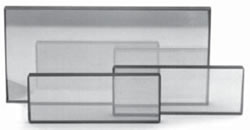|
Brewster windows operate at an angle of incidence equal
to the 'Brewster angle' which is 67.4 for ZnSe at 10.6mm. In order to
present a square profile to the incident beam, they are about 2.5 times
longer than their width. They fully transmit linearly polarized light in
the P-plane and reflect about 50% of the S-plane component.
Consequently, they can be used to enhance ('clean-up') the polarization
or by rotating it about the beam axis, they can be used as an
attenuator. Coated versions enhance the reflectance of the S-component
but at the expense of restricting the power. Usually, Brewster windows
are used in pairs.

l Wedged
to between 1 and 3 arcminutes in order to overcome multiple interference
l Coated
or uncoated versions and many sizes available
l High
quality laser grade material
Sizes/tolerances
Custom-made Brewster plates may be made in sizes up to
200mm length as long as the specified thickness is appropriate to the
size. Design tolerances for standard plates are:
|
Length |
: +0 / -0.1mm |
|
Width |
: +0 / -0.1mm |
|
Thickness |
: � 0.1mm |
|
Flatness |
: Better than λ/80 over any 25mm dia test area.
|
|
Parallelism Surface roughness |
: Wedged 2.0 � 1.0 minutes of arc. : Better than
15� RMS. |
|
LIDT cw |
: >6000W/mm (>6kW per mm of beam dia. 1/e2)
|
The Brewster Angle
The Brewster angle for a material is determined by the
index of refraction for the wavelength concerned. Where the refractive
index is �n� the Brewster angle of incidence �Ob� is given
by:
θb = TAN-1 (n)
In the case of ZnSe at 10.6μm, n = 2.4028, and θb
= 67 24'.
When specifying Brewster windows having some required
value for optical clear aperture, it is necessary to make appropriate
allowances on the width and length of the plate for the mechanical
mounting arrangement.
The following standard Brewster windows are available.
|
Model |
Material |
Diameter
mm |
ET
mm |
Incidence
deg |
T
% |
R
% |
Coating |
|
WIN-10.6-BWZ2510 |
ZnSe |
25 |
3 |
0 |
71 |
14.5 |
Uncoated ZnSe |
|
WIN-10.6-BWZ3315 |
ZnSe |
33 |
3 |
0 |
71 |
14.5 |
Uncoated ZnSe |
|
WIN-10.6-BWZE4015 |
ZnSe |
40 |
3 |
67.4 |
98% P-Pol |
99.5S-Pol |
AR/U-EB |
|
WIN-10.6-BWZ4218 |
ZnSe |
42 |
3 |
0 |
71 |
14.5 |
Uncoated ZnSe |
|
WIN-10.6-BWZ5018 |
ZnSe |
50 |
3 |
0 |
71 |
14.5 |
Uncoated ZnSe |
|
WIN-10.6-BWZE5018 |
ZnSe |
50 |
3 |
67.4 |
98% P-Pol |
99.5S-Pol |
AR/U-EB |
|
WIN-10.6-BWZ5320 |
ZnSe |
53 |
3 |
0 |
71 |
14.5 |
Uncoated ZnSe |
|
WIN-10.6-BWZ6122 |
ZnSe |
61 |
3 |
0 |
71 |
14.5 |
Uncoated ZnSe |
|
WIN-10.6-BWZ6323 |
ZnSe |
63 |
3 |
0 |
71 |
14.5 |
Uncoated ZnSe |
|
WIN-10.6-BWZ6625 |
ZnSe |
66 |
3 |
0 |
71 |
14.5 |
Uncoated ZnSe |
|
WIN-10.6-BWZE6625 |
ZnSe |
66 |
3 |
67.4 |
98% P-Pol |
99.5S-Pol |
AR/U-EB |
|
WIN-10.6-BWZ10038 |
ZnSe |
100 |
3 |
0 |
71 |
14.5 |
Uncoated ZnSe |
|
WIN-10.6-BWZ11542 |
ZnSe |
115 |
3 |
0 |
71 |
14.5 |
Uncoated ZnSe |
|
WIN-10.6-BWZ13248 |
ZnSe |
132 |
3 |
0 |
71 |
14.5 |
Uncoated ZnSe |
Applications
Polarization-forcing
ZnSe Brewster windows may be used within a laser
resonator so as to force the laser to emit linearly polarized radiation.
Polarizers/analysers
Outside a laser cavity, plates may be used singly or in
�stacks� to perform the role of polarizers or analysers.
Isolators
A particularly useful function of Brewster plates occurs
in the laser-processing of highly reflective metals, where
Brewster-based �isolator� assemblies and phase-retarder units may be
used to prevent back-reflected radiation from re-entering the laser
resonator.
Wedge Angle
If the level of parallelism of the Brewster window is
high, then multiple interference between beams reflected from the two
surfaces can affect the intended function of the plate. Our Brewster
plates are deliberately wedged to between 1 and 3 arcminutes in order to
overcome this problem.
Enhanced Brewsters
Plates with special coatings to enhance the polarizing
function are available.
|
